- Quality of academic partner institutions
- Definition of the Criterion
- Key Questions
- Notes on the sub-criteria
- References
- Further criteria
Definition of the Criterion
What is meant by ‘Quality of academic partner institutions’?
Key to the success of any cooperation is finding the right partner institution for the German higher education institution concerned. Whether or not a cooperation yields a positive outcome essentially comes down to whether the partners are working towards the same goals. Such objectives are closely bound up with internal higher education policy strategies and approaches. As such, higher education institutions should ask themselves to what extent their partner or a given academic department abroad is a good institutional and thematic fit for them, and how far it would augment their activities in a worthwhile way.
Cooperation can range from individual projects and joint study programmes to more ambitious projects such as transnational education projects, branch campuses and setting up binational higher education institutions.
Key Questions
A. Reputation of the foreign higher education institution
- Where does the institution stand in international and national rankings, where available?
- Is information available on how many publications there are in peer-reviewed journals?
- How much research funding has the partner institution been able to raise from national and international third parties?
B. Quality of teaching and research
- Is adequate basic funding available? How significant is third-party funding, such as funding from tuition fees and research commissions?
- How does the institution guarantee the freedom of teaching and research?
- Do disadvantaged groups have sufficient access to the institution?
- Which academic issues does the partner institution focus on? Does it demonstrate excellence in research in any academic departments?
- Which fields present particularly high levels of complementarity with your own institution?
- What particular opportunities arise from access to equipment, field research options or rights to award doctorates where these are not available in your own institution?
- Does the higher education institution belong to regional research or innovation clusters on which your institution can capitalise?
- Does the higher education institution transparently communicate the selection and assessment criteria for scholarships and co-funding, where appropriate? Are selection decisions made in a professional and transparent way?
C. Internationalisation
- Has the foreign higher education or research institution developed an internationalisation strategy?
- Does the internationalisation strategy prioritise cooperation with Germany, with your own academic discipline or with your type of institution (universities of applied sciences)?
- Is the strategy being implemented? Are there any resources and incentives for internationalisation?
Notes on the sub-criteria
A. Reputation
The position of a partner higher education institution in international and national rankings offers an initial way into this question. It is important here to scrutinise the selection criteria and weightings applied, as these can cause considerable variation in the different ranking positions. Some rankings weight on marketing aspects heavily (Webometrics, for example) but say little about quality, although such aspects may make a difference to the partner’s regional reputation. Of greater importance in academic circles are the scope and frequency of an institution’s publishing activities and its fundraising for research.
One-to-one conversations with representatives of the DAAD’s global network and headquarters staff, which can be arranged through the Centre for International Academic Cooperation hotline and ticket system, are a good opportunity to find out about the reputation of a foreign higher education institution. The DAAD provides further support for higher education institutions through the regional peer-to-peer events arranged by the Centre for International Academic Cooperation, as well as country-specific services provided by the International DAAD Academy, which facilitates exchange with specific higher education institutions abroad.
It is also possible to obtain information from higher education associations and funding institutions in partner countries about the higher education landscape and the reputations of higher education and research institutions in that host country. The ‘education partnerships and partner organisations’ and ‘relevant institutions’ chapters of the DAAD Education System Analyses (BSA and BSAi) are particularly relevant sources of information about partner countries in this regard. The chapters cover major international education providers and their activities, key partner organisations of German institutions, potential partner institutions, responsible funding bodies and intermediaries, higher education associations and stakeholders.
In many cases cooperation comes about through professional contacts between individuals. Information contained in bibliometric databases may be referred to in order to assess individual research profiles. Examples of these are the databases of peer-reviewed literature Web of Science, Scopus and Dimensions, where full access is available on a paid-for basis. The DFG’s GEPRIS database offers another relevant source of information on individual and institutional research profiles.
B. Quality of teaching and research
When assessing the quality of teaching and research, ethical perspectives are no less important than academic considerations. Such perspectives concern, for example, the content and design of study programmes and curricula, freedom in teaching and research, equal access to higher education and to the practice of teaching and research, data protection for students, researchers and higher education institution staff, along with the involvement and advancement of alumni. Other points of reference include levels of fundraising from third parties and national research indices, where these exist. DAAD Offices exist in many countries, possessing the expertise needed to provide tailored support to higher education institutions looking for suitable partner institutions.
C. Level of internationalisation
As regards the sub-criterion of internationalisation, two aspects should be given particular consideration: firstly, the number and nature of higher education cooperation projects with the partner university concerned, and secondly funding programmes for student and researcher mobility. The number of international students and academics are also significant indicators that help to assess the level of internationalisation for the partner institution concerned.
The internationalisation strategy of a prospective partner higher education institution (if one exists) demands particular attention. It can be possible to discern from such strategies whether the higher education institution sees its international activities only as a recruitment tool or if there is a deeper understanding of internationalisation as a transformative process for the institution as a whole. They also show if administrative structures are also the focus of internationalisation activities and not just teaching and research. It is increasingly the case that higher education institutions’ internationalisation strategies also concern key issues such as digitalisation, sustainability and diversity. These make it possible to identify the level of overlap between the two institutions in those fields that shape higher education practice.
References
This section lists some reference sources to facilitate initial evaluations. The most important sub-criteria are supplied first, followed by the information available from each source. By way of qualification, it should be noted that easily-accessible written resources are not always available worldwide for the sub-criteria listed below. With this in mind, the DAAD continues to expand its comprehensive advice services by offering opportunities for one-to-one conversations such as those provided by the Centre for International Academic Cooperation.
A. Reputation
Reputation Rankings
The two most widely known and used rankings are the QS World University Rankings and the Times Higher Education: World University Ranking. Both sets of rankings now allow users to select specific indicators to consult rankings for a given region and thereby compare potential partners. For Europe, U-Multirank rankings provide filtering functions and offer more information on teaching quality. You can stipulate your priorities, making it easier to find a partner which is the right fit. However, the impact of reputation itself is not yet as high as for the two other rankings above. When comparing positions, it is also worth consulting the Academic Ranking of World Universities (ARWU) and the U.S. News and World Report Best Global Universities Rankings.
Each of the rankings surveys different criteria and prioritises different aspects. In 2017, GATE-Germany published a comprehensive study of the profiles and classification of international higher education rankings: GATE-Germany (2017): International higher education rankings and their significance for higher education marketing (in German).
National higher education rankings provide information for single countries, such as the Sunday Times and The Times Good University Guide and the Guardian University Guide. The DAAD can also provide rankings for other countries if required.
DAAD Education System Analyses (BSA) and Analyses of Individual Education Systems (BSAi)
The DAAD Education System Analyses provide a systematic description of both higher education systems and of education systems. The analyses also present comprehensive analyses of higher education systems, including information on types of higher education institutions and degree systems, access to higher education and types of degrees, internationalisation, educational cooperation and the status of the German language. Users of the DAAD Individual Education System Analysis (BSAi) can select topics or countries to create individual comparisons of different education systems. The BSA also offer practical advice on initiating higher education relationships and stays abroad.
DFG GEPRIS database
The GEPRIS Database lists DFG-funded projects in basic research from the early 2000s onwards. The database provides information on the funding measures of the German Research Foundation. Users of the database can find out about academic projects and the researchers involved in them. The database allows users to filter by projects with international connections to specified countries. It is also possible to search for projects by academic discipline.
Bibliometric databases
Information contained in bibliometric databases may be referred to in order to assess individual research profiles. Web of Science, Scopus and the comparatively new Dimensions database hold bibliometric data on peer-reviewed academic literature. They provide information on research outcomes from around the world and offer intelligent tools for analysing and visualising the data. Full access to Web of Science is only possible on a paid-for basis. Scopus provides free access to the database via the Scopus Preview function. Some parts of the Dimensions database are also freely accessible. Full access to the databases and analytical functionality of Scopus and Dimensions is only possible on a paid-for basis.
Centre for International Academic Cooperation (KIWi) and the DAAD network of experts at home and abroad
Together with the DAAD’s global network, KIWi provides ongoing support to German higher education institutions by offering one-to-one consultations to help them identify new countries for cooperation projects and find cooperation partners there. The centre offers regular peer-to-peer events for German higher education institutions. It is also currently constructing a comprehensive database of experts on a range of topic areas. Users can access tailored advice and the assessments and views of DAAD experts in Germany and abroad. These experts are familiar with the foreign higher education systems concerned and are able to provide assessments of them.
DAAD Networking Conference
Every other year the DAAD organises the ‘NEKO’ networking conference. One of the goals of the conference is to identify suitable cooperation partners in foreign higher education institutions and research institutions. The DAAD gauges interest among potential partners in selected regions and arranges meetings after the conference to initiate partnerships.
International DAAD Academy (iDA)
The International DAAD Academy offers a wide range of seminars and training courses for those employed in higher education teaching, research, administration and academic management. With around 100 courses a year, the iDA’s range of services on internationalisation in Europe is the most comprehensive in Europe. It regularly holds regional competence seminars on various countries and regions. The senior desk officers are recognised experts with years of practical experience gained in-country, making this a space for one-to-one conversations that include views on individual institutions or types of institution in selected countries.
GATE-Germany
A wide range of information on several higher education systems and detailed country profiles in German are available from the GATE-Germany consortium for international higher education marketing, which is funded by the Federal Ministry of Education and Research (BMBF). The GATE-Germany office is located within the DAAD, and higher education institutions can commission assistance for finding clusters of suitable partners.
C. Level of internationalisation
German Rectors’ Conference, International university partnerships
The German Rectors’ Conference has created the International university partnerships portal, which provides information about where potential partner institutions for German higher education institutions are already involved in partnerships. As part of the service provided by the German Rectors’ Conference, the portal includes information on the international partnerships of German higher education institutions. Information is regularly updated by the higher education institutions themselves. The portal also allows users to search for partnerships with specified countries and see if the partner institution already maintains contacts with other German higher education institutions.
Further criteria
 © DAAD
© DAAD
 © DAAD
© DAADCriterion 1: Security situation
 © DAADCriterion 2: Wider political imperatives
© DAADCriterion 2: Wider political imperatives
 © DAAD
© DAAD
 © DAADCriterion 3: Constitutional and sociopolitical framework
© DAADCriterion 3: Constitutional and sociopolitical framework
 © DAAD
© DAAD
 © DAAD
© DAAD
 © DAAD
© DAADCriterion 4: Opportunities and risks of the respective academic system
 © DAAD
© DAAD
 © DAAD
© DAADCriterion 6: Integration into institutional strategies
 © DAADKIWi Compass ‘No red lines’ Homepage
© DAADKIWi Compass ‘No red lines’ Homepage
 © DAAD
© DAAD